_We may earn revenue from the products available on this page and participate in affiliate programs. Learn more ›
_
Best Overall
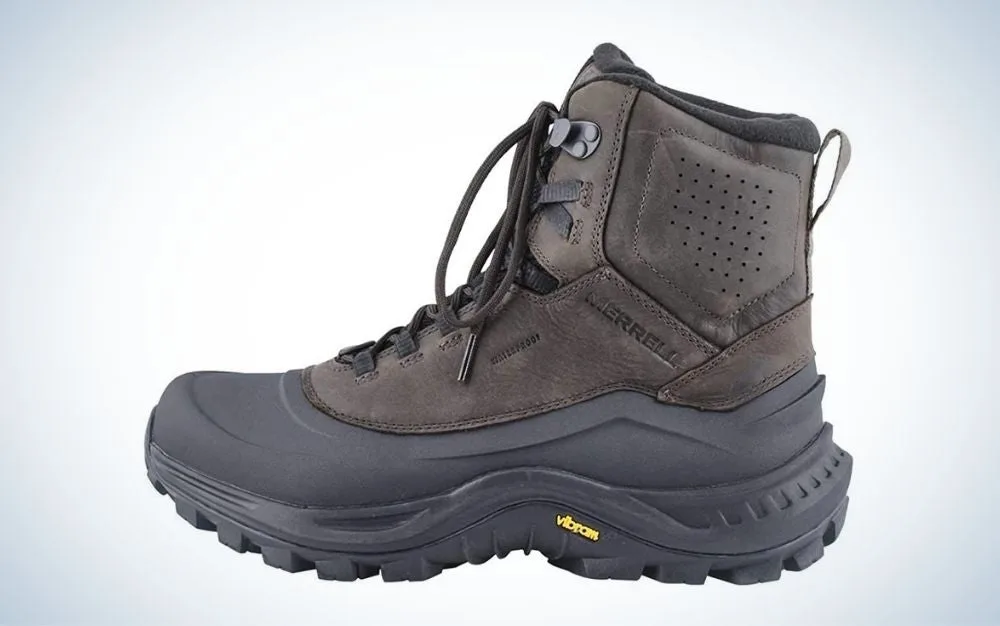
Merrell Thermo Overlook 2
LEARN MORE
Summary
The boot is constructed with a full-grain leather upper with a rubber wrap-around band that extends high enough on the boot to ensure plenty of waterproof coverage when walking in wet, snowy conditions.
Best Rubber

Muck Boot Arctic Ice
LEARN MORE
Summary
The durable rubber exterior will follow past your ankle and up your leg to be finished off with a neoprene upper that fits snuggly to your calf.
Best Leather
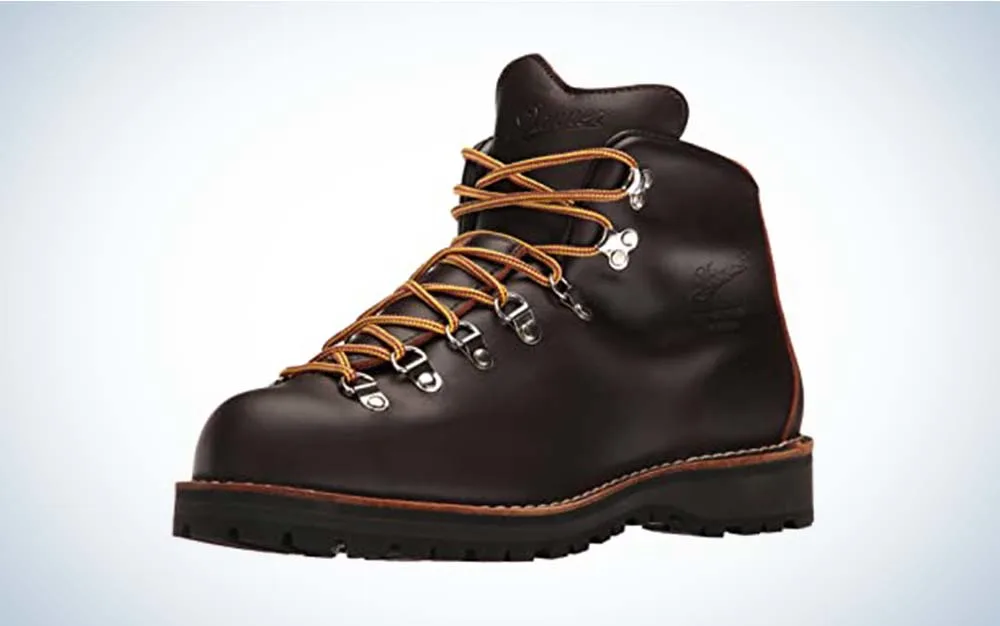
Danner Mountain Light
LEARN MORE
Summary
The Vibram Ketterlift outsole provides ample traction on wet surfaces and does an excellent job absorbing shock in the heel when hiking on uneven terrain.
As seasons change, so does the gear we need to be safe and comfortable outside. Having a good pair of winter hiking boots
ensures an enjoyable experience when hit the trail in the colder months. But depending on where you live, winter will look and feel different. When most of us think of winter, we think of snow-capped mountains, icy trails, and blustery cold conditions, but that’s not always the case.
No matter what winter looks like where you live or where you’re traveling, you can find the proper footwear for your needs. We’ve spent hours hiking the trails, scaling mountain ridges, and just trekking through snow to find the best winter hiking boots for every occasion.
Best Overall: Merrell Thermo Overlook 2
Best Insulated: Columbia Powderhouse Titanium Omni-Heat 3D Outdry Boot
Best Rubber: Muck Boot Arctic Ice
Best Leather: Danner Mountain Light
Best for Snowshoes: Salomon X Ultra Winter CS WP 2
How We Picked the Best Winter Hiking Boots
Growing up in rural Minnesota, I know cold, harsh winters well. From trudging through the snow hunting with my grandfather to sub-zero winter camping expeditions, proper footwear would make or break my day outside. I’ve tried a wide variety of boot designs since I was a kid and through my adult years, giving me a well-versed look into the types of boots that work, and where many boots may fall short.
So, when choosing the boots to put on this list, I was very particular about analyzing functionality in design and application by primarily looking at:
Materials: I looked for durable materials and reinforcement in high wear areas like the toe box, cuffs, and laces.
Insulation: I identified the type of insulation, the thickness, and if it continues to insulate when wet.
Waterproofing: I made sure the outsole of the shoe extends up over the toe and covers the sides some. The lower part of the boot should be fully waterproof materials, the upper shoe should at the very least be treated, the shoe interior can have some waterproofing capabilities, and features should protect against moisture entering the shoe.
Features: The primary features I looked for should ensure further waterproofing, but other features I keyed in on should improve functionality for your intended use (i.e., gaiter rings).
Other aspects like company sustainably practices, verified customer reviews, repair policies, warranty information, and overall durability were taken into consideration as well.
Best Winter Hiking Boots: Reviews and Recommendations
Best Overall: Merrell Thermo Overlook 2
Best Overall

Specs
Weight: 2 pounds 9 ounces
Insulation: 200g M Select
Best Use: ice and mixed winter conditions
Pros
Protection: durable, waterproof, insulated
Design: sturdy build with great traction
Variation: different Overlook insulation options
Cons
Height: low shaft height (6.5 inches), not great for deep snow
Merrell embodied a classic all-around do it all boot design with their Thermo Overlook 2. While this specific Overlook design only has 200 grams of insulation, their Tall Waterproof version
utilizes 400 grams of insulation. The tall version also solves the issue of a low shaft height, but it tends to be a bit stiff and clunky compared to the Thermo Overlook design.
The boot is constructed with a full-grain leather upper with a rubber wrap-around band that extends high enough on the boot to ensure plenty of waterproof coverage when walking in wet, snowy conditions. The Arctic Grip Vibram soles are the best of the best for winter shoe traction, and the 5mm lug depth of the soles minimizes snow build-up while you walk.
While the insulation may seem on the light side, it offers enough warmth without being too bulky. To make the Outlook’s a fantastic all-around winter hiking boot design, Merrell tacked on some great features like gaiter rings and strap ridges in the rubber for traction devices and snowshoes.
Best Insulated: Columbia Powderhouse Titanium Omni-Heat 3D Outdry Boot
Best Insulated
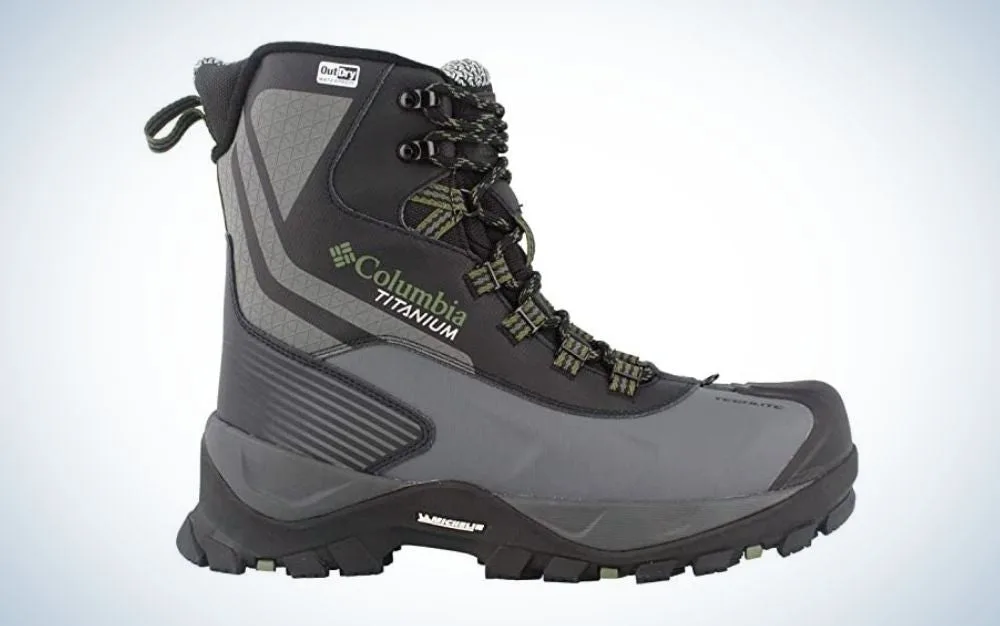
Specs
Weight: 1 pound 7 ounces
Insulation: 600g
Best Use: extreme winter conditions
Pros
Waterproofing: waterproof leather, webbing, and nylon
Traction: high-grip anti-slip Michelin outsole
Insulation: 600g insulation with Omni-Heat reflective lining for added warmth
Cons
Temperature Rating: listed at -65 degrees F, but likely only comfortable down to -25 to -40 at best
Finding a cold-weather hiking boot can mean you compromise mobility with clunky, heavy boots in the name of warmth and comfort. The Columbia Powderhouse Titanium Omni-Heat 3D Outdry Boots give you the best of comfort, warmth, and mobility.
Be wary of their low-temperature rating of -65F, as this isn’t necessarily an accurate read of comfort while you’re hiking. The thickness of the insulation and Omni-Heat technology does help to keep your feet comfortable in very cold conditions but also keep in mind Omni-Heat only works when you’re producing high levels of body heat which means you’re moving.
These boots have an ideal height to stop snow from entering the top of the boot, have a waterproof-breathable upper and Techlite shell. Colombia used the high-grip anti-slip Michelin outsole, which provides excellent traction on slippery and varied surfaces. The intentional wrap-around design also takes into account you may use traction aids and gaiters. They also have a women’s option.
Best Rubber: Muck Boot Arctic Ice
Best Rubber

Specs
Weight: 2 pounds 8 ounces
Insulation: 8mm neoprene, fleece lining
Best Use: working outside or hunting in cold, wet, muddy conditions
Pros
Waterproof: can wade through water with no leaks
Height: tall design for deep mud or snow
Traction: Vibram Arctic Grip outsole
Cons
Sizing: great for narrow feet, and thin calves
Anyone that has to trudge through the snow, work in mud, or walk through tall, wet grass on a hunt can agree that having a warm rubber boot would be ideal. Muck Boots heard this call and took action by designing their Arctic Ice boots, our pick for best rubber hiking boots. These come in tall and mid heights as well as men’s and women’s sizes. There is an Arctic Sport
boot that is comparable but better for milder conditions due to thinner insulation.
The durable rubber exterior will follow past your ankle and up your leg to be finished off with a neoprene upper that fits snuggly to your calf. The snug upper fit is seen as a con to some people, but it does help prevent and debris or snow from entering the top of the boot. While neoprene alone can be a warm insulator, the added fleece adds to the comfort and warmth of the boot.
The Arctic Ice utilizes the Vibram Arctic Grip outsole to ensure traction even on ice. These don’t work the best for extended treks or with traction aids, but they are one of the best options for those needing the full waterproofing rubber boots can provide.
Best Leather: Danner Mountain Light
Best Leather
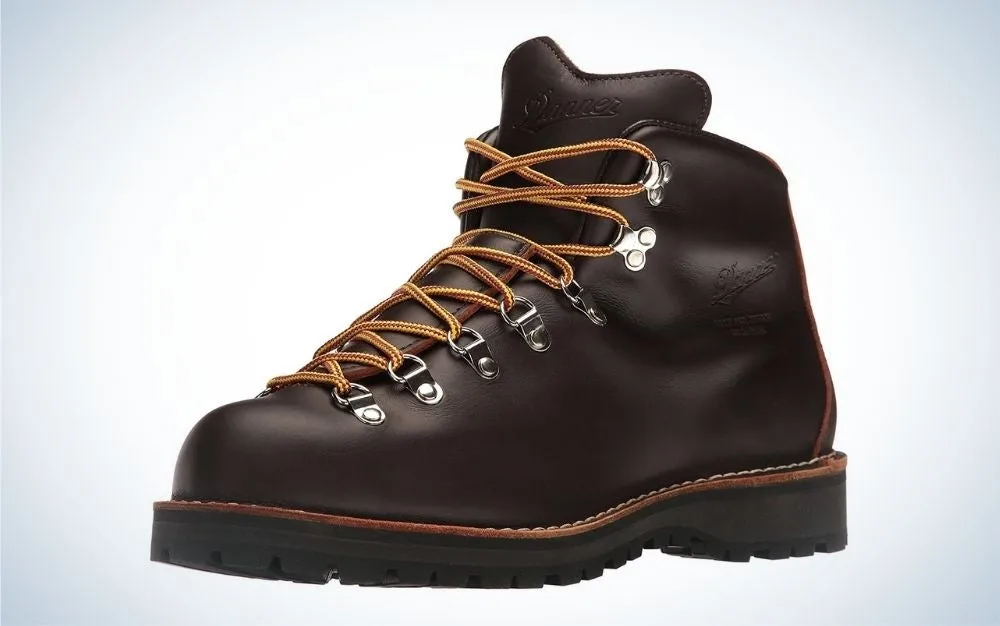
Specs
Weight: 3 pounds 9 ounces
Insulation: non-insulated
Best Use: hiking in mild winter weather
Pros
Waterproof: one-piece leather with Gore-Tex liner
Durable: full-grain leather
Lightweight: minimal design for optimal movement
Cons
Non-Insulated: Gore-tex liner but no insulation
Height: slightly over the ankle, no cuff
The Danner Mountain Light may not appear to be a classic winter hiking boot, but if you live in an area with mild winter conditions and only need a waterproof shoe, these are a great pick. The handcrafted design utilizes a one-piece leather tongue to prevent debris or snow from entering the shoe.
Although there is no insulation, it does have a Gore-Tex liner making it waterproof and comfortable to wear when walking on a trail with a light dusting of snow. Even with the Gore-Tex lining, the shoe is breathable enough to allow moisture to evaporate as you hike to prevent cold feet in cold conditions.
The Vibram Ketterlift outsole provides ample traction on wet surfaces and does an excellent job absorbing shock in the heel when hiking on uneven terrain. The shoe offers a comfortable yet stable fit that works well for hikers with wide feet. These are not the standard winter hiking boot meant to take trudging through deep snow or icy streams, but they are a boot that will serve you well through mild winters and shoulder seasons.
Best for Snowshoes: Salomon X Ultra Winter CS WP 2
Best for Snowshoes
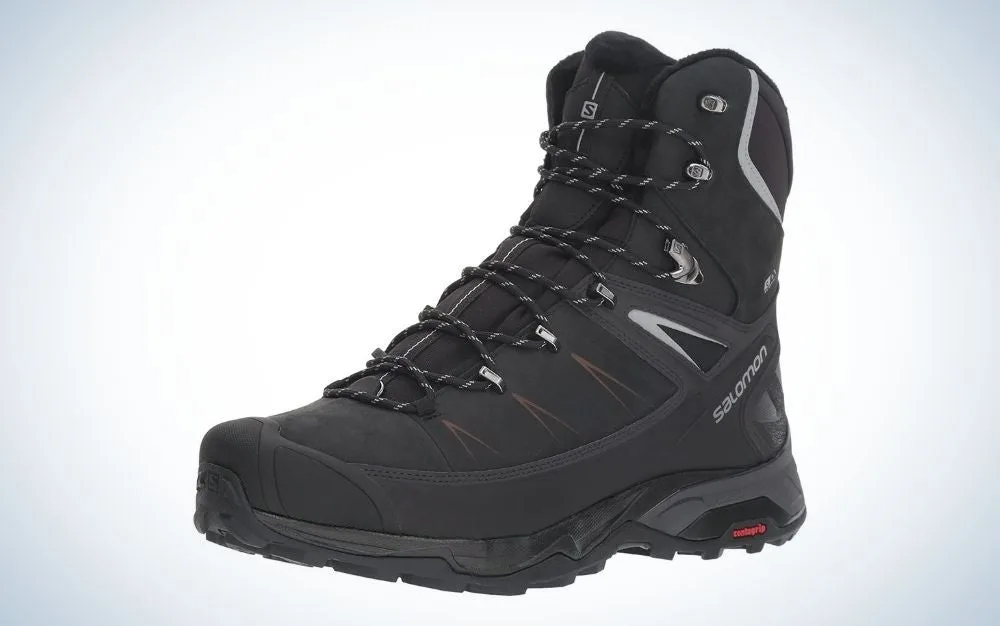
Specs
Weight: 1 pound 3 ounces
Insulation: 200g Thinsulate
Best Use: long winter treks and snowshoeing
Pros
Adjustable: easy to use lace system
Traction: great grip on slippery surfaces
Compatibility: works well with traction aids and snowshoes
Cons
Debris can get caught up on soles and in upper
There are several winter hiking boots on our list that work with snowshoes
and traction aids. Still, Salomon X Ultra Winter Boots is our pick for best boots for snowshoes
because they are comfortable for long treks and compatible with various snowshoe and crampon designs. These boots provide the fit and feel of a trail runner and the protection of top-of-the-line winter boots, perfect for long treks.
The shoe upper does not provide a tall shaft for coverage, but they are compatible with gaiters. Since you’ll likely be wearing snowshoes with these boots, though, collecting snow at the top of your boot shouldn’t be too much of a problem. Overall, the shoe has excellent traction, but if there are a lot of rocks and mud, debris may build up some.
They provide 200 grams of insulation, perfect for the cold weather athlete to ensure their feet stay warm, but their boot is not too bulky. With that in mind, these boots are designed for movement in the cold, and your feet may get cold if you’re wearing them while stationary for too long.
What to Consider When Choosing Winter Hiking Boots
Defining the best winter hiking boots becomes a very personal endeavor and is very dependent on the area you live and hike in the winter, the temperatures, and how often you plan to use them. To help you narrow down the many fantastic options available, I’ve broken down the top five considerations to make before buying winter hiking boots.
Climate and Terrain
Winter in the Sonoran Desert looks far different than winter in the Cascades or even the rolling hills of the Midwestern Prairie. The type of weather, terrain, and general climate drastically impact your needs in terms of winter hiking boots.
You know the area you live in best, but you may also need to research some weather trends and trail reports if you are traveling to a place you’re unfamiliar with. Acknowledge things like the average precipitation, average temperatures, wind chill, and the type of terrain you’ll be traveling over. Are you hiking in an exceptionally wet area? Or is it a dry climate with occasional bouts of snow? Are the trails well known for snowdrifts or ice?
Identifying these things helps you target the specific design features you need, discussed in more detail below.
Insulation and Lining
The level of insulation and necessary temperature rating of the boot you choose depends on the area you are hiking. Using the same hiking boots you use all summer can be doable in some areas, mainly if you utilize waterproofing and extras like gaiters. Still, in colder, wet climates, boots specifically designed for winter hiking prevent frostbite and provide more comfort.
Not all boots have the same insulation or lining, and each option has its pros and cons. The most common types of insulations include:
Wool and sheepskin: Common natural boot linings are often a wool felt or made from sheepskin. These can be bulkier, but they are extremely effective and will continue to insulate even when wet. Most of these types of linings are removable.
Down: One of the less common types of insulation, but not unheard of in winter boots. Unlike the natural wool felts and sheepskin liners, down insulation does not insulate when wet. This makes it a poor choice for wet climates or areas that require trudging through snow. These are more common for causal winter boots or a basecamp boot because they are still quite warm.
Synthetic: Perhaps the most common type of winter boot insulation on the market today. Insulations like Thinsulate, Primaloft, Heatseeker, and Omni-Heat are all examples of synthetic insulation. How warm synthetics are is usually based on the weight in grams. For reference, midweight boots will be around 400-grams, making them great for cold conditions during moderate activity.
Other than the type of insulation itself, the liners vary:
Removable: Having a removable liner is positive for two primary reasons. First, they will dry faster because you can take the liner out of the boot, making them ideal for expeditions. Second, the liner can easily be replaced. The boot’s exterior will be far more durable than the interior liner, and the liner is often what wears out the fastest. So, instead of replacing the whole boot when the liner wears down, you only have to replace one part of the boot. The downside of a removable liner is that it is not attached to the rest of the boot, which can cause some movement while you hike.
One-piece boots: When the boot is all one piece, the liner is not removable. This type of boot design often provides a better fit, feel, and stability on the trail. They help keep the weight and bulk of the boot down in most cases, and having lightweight hiking boots is ideal for activities like snowshoeing or extended hiking trips.
Something you may notice as you shop is that many winter boots have a manufacturer temperature rating. These can be a decent signifier of how much warmth the boot will provide, but these are not standardized and vary from brand to brand. There are also comfort ratings listed on some winter boots, but just as temperature ratings, these are not necessarily reliable. Things like your age, activity level, type of socks you’re wearing, and general circulation will all impact the comfort or temperature ratings. Plus, they’re likely to feel different when you’re moving versus when you’re stationary.
All that to say, temperature and comfort ratings do not provide a consistent rating across all brands in terms of insulation type, boot models, and the amount of insulation within the boot. They can give you a general idea, but be more vigilant when looking at the type of insulation and lining when shopping versus the listed temperature or comfort rating.
Waterproofing
Since winter in most areas means wetter weather in one way or another, waterproofing is a top consideration when buying winter hiking boots. When looking at boots online, take note of the words used to describe the protection from moisture. Waterproof designs are very different from water-resistant boots, will be made from different materials, have different warmth factors, and have different types of treatments to prevent water from reaching your foot.
Most winter hiking boots will have a waterproof shell of some kind. Even if the entire shell is not made of a waterproof material such as rubber, there will likely be rubber or similar material covering the toe and lower part of the foot. Then, another material will create the upper of the boot, often a treated leather or synthetic material that is more water-resistant than waterproof.
Many boots with removable liners will rely on a much burlier exterior shell. And one-piece boots often have a breathable membrane of some kind between the waterproof outer layer and the built-in insulation. This type of design tends to be slightly less waterproof, so the boot’s exterior should have a waterproof treatment.
Even if your boot has waterproofing treatments and plenty of waterproof materials creating the boot’s outer shell, this means nothing if snow and water can easily enter the top of your boots. Gusseted tongues that connect to the upper of the boot can help keep some moisture out even when wading through puddles, but taller boot designs are ideal for walking through snow. Excessively deep snow may require the use of gaiters to create a better barrier.
Traction
Hiking in the winter can lead to some icy and wet conditions, meaning you need a boot that can help you stay in control and stable no matter what. Snow boots, in general, utilize a lug pattern traction design with a rubber compound that is softer than standard hiking boots and doesn’t harden in cold temperatures. The soft rubber helps the boot grip on snow and ice, and the lug pattern prevents snow from building up on the bottom of the show as you walk.
As part of the traction design, outer soles on winter hiking boots tend to be very thick to protect your feet from impact and absorb energy. Some types of winter hiking boot rubber are specific to brands, like Vibram, a standard rubber found on various shoes. Vibram designed a rubber with Arctic Grip that is now used widely in the outdoor industry for winter hiking shoes.
Even with the best winter hiking boot rubber and traction design, you may need extra traction on the trail from things like microspikes or Yaktrax.
Winter Weather Design Features
Like any other type of hiking shoe, winter hiking boots come with various design features.
Winter specific features you may want to consider having include:
Reinforced Toe Cap: These can provide better protection from impact and for waterproofing. It will also work well with traction add-ons like crampons or microspikes.
Gusseted Tongue: When the boot’s tongue is sewn into the sides to prevent water and snow from making their way into your boot when hiking.
Cuff: These should be made from strong, durable materials to avoid premature wear and is designed to close the gap between your leg and the boot to further protect against moisture from entering the boot.
Gaiter Ring: While not a necessary feature, it is nice if you often wear gaiters. This is a small metal ring on the toe of your boot that provides a secure spot for your gaiters to attach. Otherwise, they attach to your laces.
Many winter hiking boot designs will have all or most of these features, but these tend to be ideal aspects to look for when searching for functional winter hiking boots.
FAQs
Q: Which is warmer, neoprene or Thinsulate?
It depends on the application. Thinsulate helps your body retain the heat it is creating but is also breathable so it traps air, not moisture. Since neoprene is a polymerized rubber compound, it is not breathable and does not allow water to evaporate. Neoprene is also excellent at trapping heat because it is made from small, closed cells filled with air. The thicker the neoprene the warmer (and heavier) it is. Comparing the same thickness of neoprene against Thinsulate materials, Thinsulate would likely be warmer and more comfortable.
Q: Should I order a larger size for winter hiking boots?
Most people recommend that you buy any hiking shoe a half to a full size larger for a few reasons. First, when you’re hiking, your feet get larger. Second, you need room for your socks, especially if you plan to hike in the winter. Third, you need room for your foot to stabilize on all terrain and hiking downhill.
Q: What are the warmest hunting boots?
The Arctic Style Stegar Mukluks
are arguably the warmest boots in the world, rated to -40 degrees Fahrenheit or more. They utilize a reinvention of the traditional seal skin and Caribou Mukluk design traditionally worn in the Arctic. There are other winter hiking-specific boots rated to similar low temperatures include the KEEN Revel IV High Polar Winter Boots
and the Columbia Powderhouse Titanium Omni-Heat 3D Outdry Boot
. The warmest winter hunting boots are going to be the ones that check all the right boxes. They’ll have proper coverage and be waterproof as well as have high levels of insulation. Thorogood’s Endeavor Extreme
features 2,400 grams of Thinsulate insulation, making them a good choice for all-day sits in the coldest conditions.
Best Winter Hiking Boots: Final Thoughts
Best Overall: Merrell Thermo Overlook 2
Best Insulated: Columbia Powderhouse Titanium Omni-Heat 3D Outdry Boot
Best Rubber: Muck Boot Arctic Ice
Best Leather: Danner Mountain Light
Best for Snowshoes: Salomon X Ultra Winter CS WP 2
Winter looks different all across the world, and the best winter hiking boots need to match. Even if you did not find the perfect fit on our list, follow our buying considerations to ensure you invest in a hiking boot that will last you several winter hiking seasons to come.
Why Trust Us
For more than 125 years, Field & Stream has been providing readers with honest and authentic coverage of outdoor gear. Our writers and editors eat, sleep, and breathe the outdoors, and that passion comes through in our product reviews. You can count on F&S to keep you up to date on the best new gear. And when we write about a product—whether it’s a bass lure or a backpack—we cover the good and the bad, so you know exactly what to expect before you decide to make a purchase.






